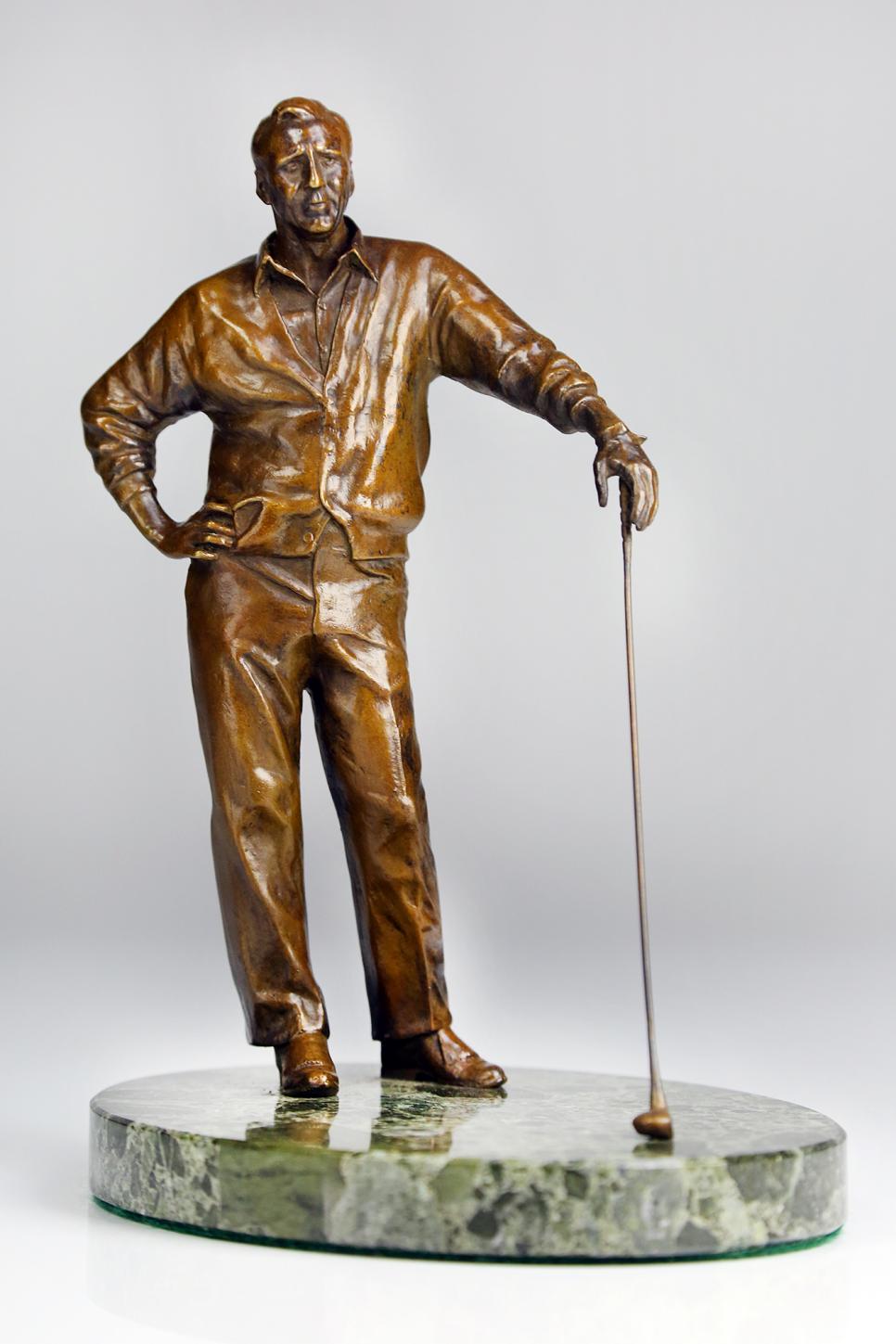News
Meet the man behind iconic Payne Stewart sculpture and our new ‘Arnie’ award
It is the bane of the successful contemporary artist that his work is usually better known than his name. In this case, his name is Zenos Frudakis. Ever heard of him?
Yet even the casual golf fan is likely familiar with the sculpture of a celebratory Payne Stewart, one leg in the air, his right fist piercing the sky, on display near the 18th green of Pinehurst No. 2 where Stewart struck this pose as he won the U.S. Open in 1999.

Getty Images
It is the work of Frudakis, 64, an internationally-acclaimed sculptor, whose wide-ranging work includes a piece called Freedom that art critics included alongside Michelangelo’s David and the Statue of Liberty on a top 10 list of public art.
Golfers, too, have found a prominent place in his oeuvre, among them Arnold Palmer, Jack Nicklaus, Bobby Jones and Stewart. Golf Digest has commissioned Frudakis to produce a trophy-sized version of his seven-foot Palmer bronze that it is calling the Arnie (shown here), to be presented to its “Golfers Who Give Back” award winners. It also is making a donation to Arnie’s Army Charitable Foundation in connection with the awards and ceremony at TopGolf Atlanta on Nov. 16.

“We’re not going to forget these people and what they accomplished and meant to us,” Frudakis said. “Bronze helps us do that because it endures. That’s the reason the Egyptians made sculpture.”
Frudakis is meticulous and his work accordingly is lifelike. When he wheeled a bust of Palmer into his office at the Bay Hill Club in Orlando, Palmer’s dog Mulligan jumped up, eyed it and began following it, his tail wagging, as though in recognition of a familiar face. “That’s one harsh critic I’ve gotten it past,” Frudakis said jokingly.
He got the entirety of the Palmer bronze past Palmer, too. It shows him leaning casually on a golf club and is on display at several sites, including the Georgia Golf Hall of Fame, Laurel Valley Golf Club in Ligonier, Penn., the Arnold Palmer Regional Airport in his hometown of Latrobe, Penn., and Tralee Golf Club in Ireland.

Frudakis, a Greek-American whose studio is in the Philadelphia area, came to art early, his drawings “a way of making sense of the world,” he said. He recalls his mother drawing a profile of a person. “I was in kindergarten,” he said. “I looked at it and thought, ‘that’s not right.’ I could see it was off. So I redrew it for her. I thought she’d be pleased. She wasn’t pleased.”
Yet his mother recognized his passion and fostered it early. She often baked home-made bread and allowed Frudakis to appropriate some of the dough and mold it into a small figure that she would then heat in the oven. “It was almost like bronze-casting,” he said.
It was the rudimentary beginning of a long and distinguished career that has taken him many places around the world, least likely among them, perhaps, the homes and offices of renowned figures from golf.
“Do you golf?” Nicklaus asked him while posing in his home adjacent to Muirfield Village Golf Club in Dublin, Ohio.
“No,” Frudakis replied.
“That’s all right, that’s all right,” Nicklaus said.
“Do you sculpt?” he asked Nicklaus.
“No,” Nicklaus replied.
“That’s all right, that’s all right,” Frudakis said, apparently with glee.
Frudakis explained that he already has one obsession, his art, and has neither the time nor the energy to take on another, notably one known to frustrate its proponents.
So he never discovered golf. Instead, golf discovered him. He was commissioned to produce a sculpture of Palmer for a project on the riverwalk in Augusta, Ga., part of an effort to renovate the downtown area. It is the piece that now resides in the Georgia Golf Hall of Fame.
Other golf projects followed, including one of Nicklaus on display in the Nicklaus Room at the USGA Museum in Far Hills, N.J.
Soon after Payne Stewart died in a freak airplane mishap in October of ’99, Frudakis was commissioned by Pinehurst Resort to capture that iconic moment when the winning putt dropped. He recalls traveling to Pinehurst and encountering a despondent Stewart family. “I remember I went into the golf shop and his son [Aaron] was sitting on the floor in a corner by himself, looking very sad,” he said. “His widow [Tracy] looked devastated.”
The sculpture he produced was unveiled in 2001, but its impact was not fully realized until the U.S. Open there in 2014. By then it had become a popular landmark at Pinehurst, when hordes of fans were photographed striking a similar pose alongside the Stewart statue, including Stewart’s daughter Chelsea. “The coolest statue photo you’ll see this week,” the PGA Tour called it on Instagram.

“It’s extremely gratifying for me, to see people take the pose, especially to see his daughter do it,” Frudakis said, “to see them interact with the piece, to see [Chelsea] laughing, smiling.
“It’s his moment of victory. It was exciting. With Payne Stewart at the peak of his career, this was his Icarus moment, to have fallen so tragically from such a high place. I think for a lot of people there is some healing for having the sculpture. The sense with bronze is that people have wanted to make something that will last because we don’t.”
No, we don’t. But those like Palmer and Stewart are historical figures who will endure to some degree anyway. Frudakis’ intricately-crafted over-sized portrayals ensure that we accurately recall them in perpetuity, as larger than life.